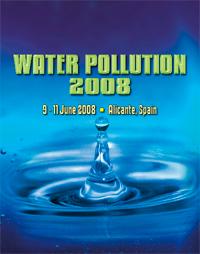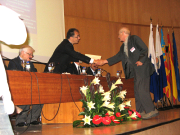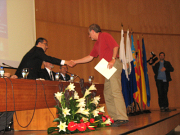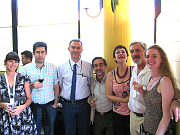Ninth International Conference on Modelling, Monitoring and Management of Water Pollution
![]() 9 - 11 June 2008
9 - 11 June 2008
Alicante, Spain
Overview
 The 9th International Conference on Modelling, Monitoring and Management of Water Pollution, that recently took place at the University of Alicante, organised by that University and the Wessex Institute of Technology. The Conference was also sponsored by the Institute of Water and Environmental Sciences of the University of Alicante and the Ministry of Education and Science of Spain.
The 9th International Conference on Modelling, Monitoring and Management of Water Pollution, that recently took place at the University of Alicante, organised by that University and the Wessex Institute of Technology. The Conference was also sponsored by the Institute of Water and Environmental Sciences of the University of Alicante and the Ministry of Education and Science of Spain. The Conference, which has always been very successful, provides a forum for the discussion, among managers, scientists and academics, of different aspects of water pollution.
The environmental problems caused by the increase of pollutant levels discharged into natural water bodies require setting up a framework for regulation and control. This framework needs to be based on scientific results that relate pollutant discharges with changes in water quality.
Over the years, the Conference has made valuable contributions to the knowledge of water pollution problems, which are essentially interdisciplinary, involving a wide range of issues. The meeting also attracts colleagues from many different countries.
The Meeting was opened by Professor Carlos A. Brebbia who referred to the long established links between his Institute and the University of Alicante. These links led to the signature of a formal link agreement a few years ago, under which several important initiatives took place, such as exchange of researchers, organisation of different meetings, collaboration with PhD theses, and a series of research visits. The collaboration was coordinated by Professor Yolanda Villacampa, Head of the Mathematical Modelling Group.
Hromadka Prize
The Rector of the University, Professor Ignacio Jimenez Raneda, chaired the opening ceremony and welcomed the delegates to his University. Following his remarks, he asked Prof Brebbia to proceed with the Award of the Hromadka Prize for Advances in Water Resources. The Prize was launched two years ago by Prof Ted Hromadka in memory of his father. Prof Hromadka, who sits on the WIT Board of Directors, is recognised worldwide for his pioneering work on the development of a new mathematical technique, as well as for his practical engineering work on hydraulics and hydrology. He has numerous publications, including papers and books, and has helped to develop better standards of practice in his native California. He holds 3 PhD degrees, one of them from WIT, and has received many honours and prizes. Until recently, he was a Professor at the State University of California at Long Beach and more recently he has been appointed Professor at West Point Academy.Carlos explained that it has been difficult to reach a decision regarding the recipient of the prize, in view of the high quality of the nominees. As a result, a number of candidates were awarded a Diploma of Excellence due to their outstanding contributions.
The Prize was given to Professor Gabriel Winter from the University of Las Palmas and Gran Canaria for a paper that describes the system developed at that Institute to fight coastal pollution problems. The title is “An integrated system for real time fight against the maritime and coastal pollution with environmental data acquisition, pollutant spillages modelling and risk management”.
Diplomas were awarded for the following contributions:
“Farmstead drinking water sources, concerns and safety practices of livestock farm families in Southern Alberta, Canada” by Manju P. Acharya, University of Lethbridge, Canada
“Hydro chemical evaluation of the quality of some Brazilian waters” by Daniel Marcos Bonotto, Instituto de Geociencias e Ciencias Exatas – UNESP, Brazil
“Study of the extracellular polymeric substances (EPS) in different types of membrane bioreactor (MBR) effluents” by Liuba Dominguez Chabalina, Water and Environmental Science Institute, University of Alicante, Spain
“Determination of the spreading-velocity of nitroaromatic compounds in aquifers represented on the basis of column tests under in situ conditions” by Fraziska Jaenig, Mull & Partner Consulting Engineers, Germany
“Absorption of zinc, cadmium and nickel from aqueous solutions by using ground water sludge” by Shamsul Rahman Mohamed Kutty, University Teknologi PETRONAS, Malaysia
“Role of high mountain areas in catchment hydromineral resources - Northern/Central Portugal: environmental issues” by Jose Manuel Vaz Velho Barbosa Marques, Institute Superior Tecnico, Portugal
“Oil spill boom modelling by the finite-element method” by Frederic Muttin, Engineering School EIGSI, France
“Modelling environmental impact on sediment caused by discharges deposited on the sea floor” by Henrik Rye, SINTEF, Norway
“Application of dynamic parametric sensitivity analysis for identifying contaminant sources in a watershed” by Jeno M. Scharer, University of Waterloo, Canada
“Preliminary analysis of water pollution in a small lake in Western Mexico” by Harvey Shear, University of Toronto, Canada
“Screening of priority pollutants in urban stormwater: innovative methodology” by Sally Zgheib, University Paris-Est, France.
The award and diplomas were given by the Rector of the University and the Ministry for the Environment of the Region, Mr Jose Ramon Garcia Anton, who agreed to come and open the Conference, in spite of his very busy schedule.



Prof Garcia Anton, who is a Civil Engineer and Professor at the University of Alicante, referred to the importance of water in his region and to the work carried out by his University to optimise its use and recovery. The Alicante region has been historically always associated with the careful use of its hydraulic resources; this irrigation system being one of the oldest in Spain.
The Minister then proceeded to officially open the Meeting.
Topics
The papers presented at the Conference were divided into the following sessions:- Coastal areas, lakes and rivers
- Groundwater and aquifer issues
- Environmental monitoring and sensing
- Remediation
- Experimental and laboratory work
- Mathematical modelling
- Oil spills
- Wastewater treatment
- Low cost technologies
- Agricultural contaminants
- Pollution protection
Invited Presentations
A series of invited papers were presented by well known authors, among them:“Thermal degradation of organic pollutant in sewerage sludge” by R. Font, Department of Chemical Engineering, University of Alicante, Spain
“Development of a sliding device for extended measurements in coastal waters” by G Zappala, Institute for Coastal Environment, CNR, Italy
“Problems in the economic management of the water treatment process in Spain” by M Sevilla, Department of Econometrics, University of Alicante, Spain
“Theoretical evolution of substituted polycyclic aromatic hydrocarbons as emerging pollutant phototoxins” by K Rowberg, Purdue University, USA
Social Activities
 There were numerous social events for the delegates to make contact outside the conference room. They were offered complimentary lunches and a cocktail at the end of the first day of the conference. In addition, there was a conference dinner on the second evening and a buffer dinner at the end.
There were numerous social events for the delegates to make contact outside the conference room. They were offered complimentary lunches and a cocktail at the end of the first day of the conference. In addition, there was a conference dinner on the second evening and a buffer dinner at the end. The banquet took place in a private room in a restaurant on the sea front which is renowned for the quality of its cuisine. There the participants had occasion to sample different local specialities and excellent wines in a relaxed atmosphere. The occasion was most enjoyable with a toast proposed to our Spanish hosts. At the end of the evening the participants were given a local piece of pottery to mark the occasion. Pottery was, and still is, one of the main crafts of the region, but the number of potteries has been steadily decreasing, partly due to the rapid building development of the region.
A buffet dinner at the end of the Conference was held in the historical Castle of Alicante, located on Mount Benacantil, a rock promontory, rising 170m above sea level. This has made the Castle a strategic point throughout its history. The fortress dates from the 9th Century when that part of Spain was under Moorish rule. Its fortifications were improved over the year by a number of Christian kings, including Philip II who carried out major improvements. It houses a number of rooms dating from that period.
ISAC Meeting and Next Conference

The Conference will be reconvened in 2010, the date and location shortly to be decided.
Publication of Papers
The proceedings of Water Pollution IX, 672pp (ISBN: 1-84564-115-3) are available in hard back from WIT Press priced at £221/US$442/€331.50. Orders can be placed by telephone: +44 (0) 238 029 3223, fax: +44 (0) 238 029 2853, e-mail: This email address is being protected from spambots. You need JavaScript enabled to view it. or via the WIT Press web site at: www.witpress.com
Papers from the conference will also be hosted online at the WIT eLibrary as volume 111 of WIT Transactions on Ecology and the Environment (ISSN: 1743-3541). For more details visit the WIT eLibrary at: library.witpress.com


 Wessex Institute
Wessex Institute